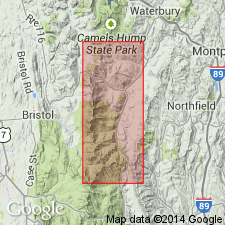
- Usage in publication:
-
- Fayston Formation
- Modifications:
-
- Overview
- Dominant lithology:
-
- Schist
- AAPG geologic province:
-
- New England province
Summary:
Name Fayston Formation was proposed by Walsh (1989: Univ. of VT, MS thesis) to describe a group of rocks in which the primary unit is the muscovite-quartz-albite-chlorite schist that contains abundant porphyroblasts of white to light gray albite, commonly referred to as the white albitic schist. It was included within the Underhill by Christman and Secor (1961). In this study the name Underhill is applied only to rocks similar to the western sequence of Christman and Secor. Cady and others (1962) included this white albitic schist in both the Underhill and Hazens Notch Formations based on the interpretation that the Mount Abraham Schist was stratigraphically between the Underhill and the Hazens Notch. Later work suggests that the sequence is tectonic and not a simple stratigraphic succession. Use of the name Hazens Notch is not recommended for this area. The white albitic schist constitutes approximately 90 percent of the Fayston. Other lithologies include quartzo-feldspathic granofels, quartz-biotite gneiss, quartz-muscovite-tourmaline schist, and greenstone. Age is Late Proterozoic and Cambrian.
Source: GNU records (USGS DDS-6; Reston GNULEX).
For more information, please contact Nancy Stamm, Geologic Names Committee Secretary.
Asterisk (*) indicates published by U.S. Geological Survey authors.
"No current usage" (†) implies that a name has been abandoned or has fallen into disuse. Former usage and, if known, replacement name given in parentheses ( ).
Slash (/) indicates name conflicts with nomenclatural guidelines (CSN, 1933; ACSN, 1961, 1970; NACSN, 1983, 2005, 2021). May be explained within brackets ([ ]).

